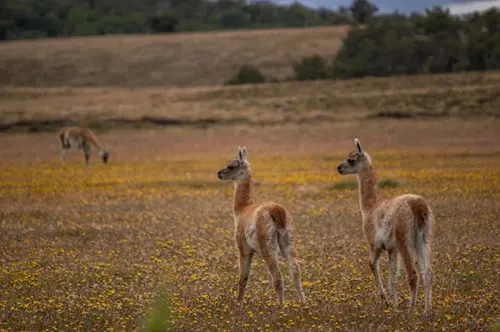
By: Fiona Madrid
Karwkynka
The Ñirre above my tent creaks with the strong westerlies of Tierra del Fuego. It is 6AM, and freezing, and I cannot sleep a wink. I sneak out of my tent and walk into the vast pampa with my field notebook, lying down in the honeydewed bunch grasses where Michael taught me to play Euchre twelve hours before and thinking about the class we just had on nativity.
An organism’s nativity, as Professor Shaw described it, is to do with one’s relation both to a land over time and to its ecosystem. Any species inhabiting a space for long enough (infuriatingly vague), fulfilling a particular niche, and without the capacity to dominate its ecosystem can be considered functionally native. These criteria allow us to categorize species which were introduced and have naturalized over time as nativeish. Guanacos for example–one of the most recognizable species in Tierra del Fuego–are not traditionally native to this land because they were eliminated by a tephra-ash layer from a Hudson volcanic eruption 7,750 years ago. Then humans reintroduced them to this geologically isolated archipelago a couple thousand years later, and they reclaimed their niche. So, while they may not be evolutionarily native, they are functionally native.
Scribbling this in my notebook, I spot two gray foxes poking around our campsite, and they look up at me. They sense I’m going to write about them. Towards the sunrise, a small band of debatably native horses graze. The three foals stick close to their mothers while the largest stallion guides them across the field, parting the guanaco herds like the red sea. The stallion has the most beautiful brown coat, black mane and a white stripe down his nose. And I realize as I’m studying him that this wild horse has gotten dangerously close to me. I stand slowly, planning a tactful retreat back to my Ñirre. Before I can turn away, he bows at me. I barely register it, but then he makes his final approach and nudges my outstretched hand. His nose is soft, his slight movements hold enough strength to knock me clean over. The other horses and foals follow closely behind, watching us.
These animals are not afraid of us–the foxes who scavenge our site for camper scraps, the guanacos who trill their lips in disapproval when we make too much noise on the trails, the horses who comfort sleepless students journaling in the field. They are native here, to the pampa and the nothofagus forests of Karwkynka. They wield the authority to welcome us or reject us. I am so incredibly envious of them; I do not belong this way anywhere. I’m confident very few people do. Oh, to touch the tip of my stallion’s nose and tell him that I, too, am native in my homeland.



Related Posts

Camila Rojas: Alumni Spotlight⭐
